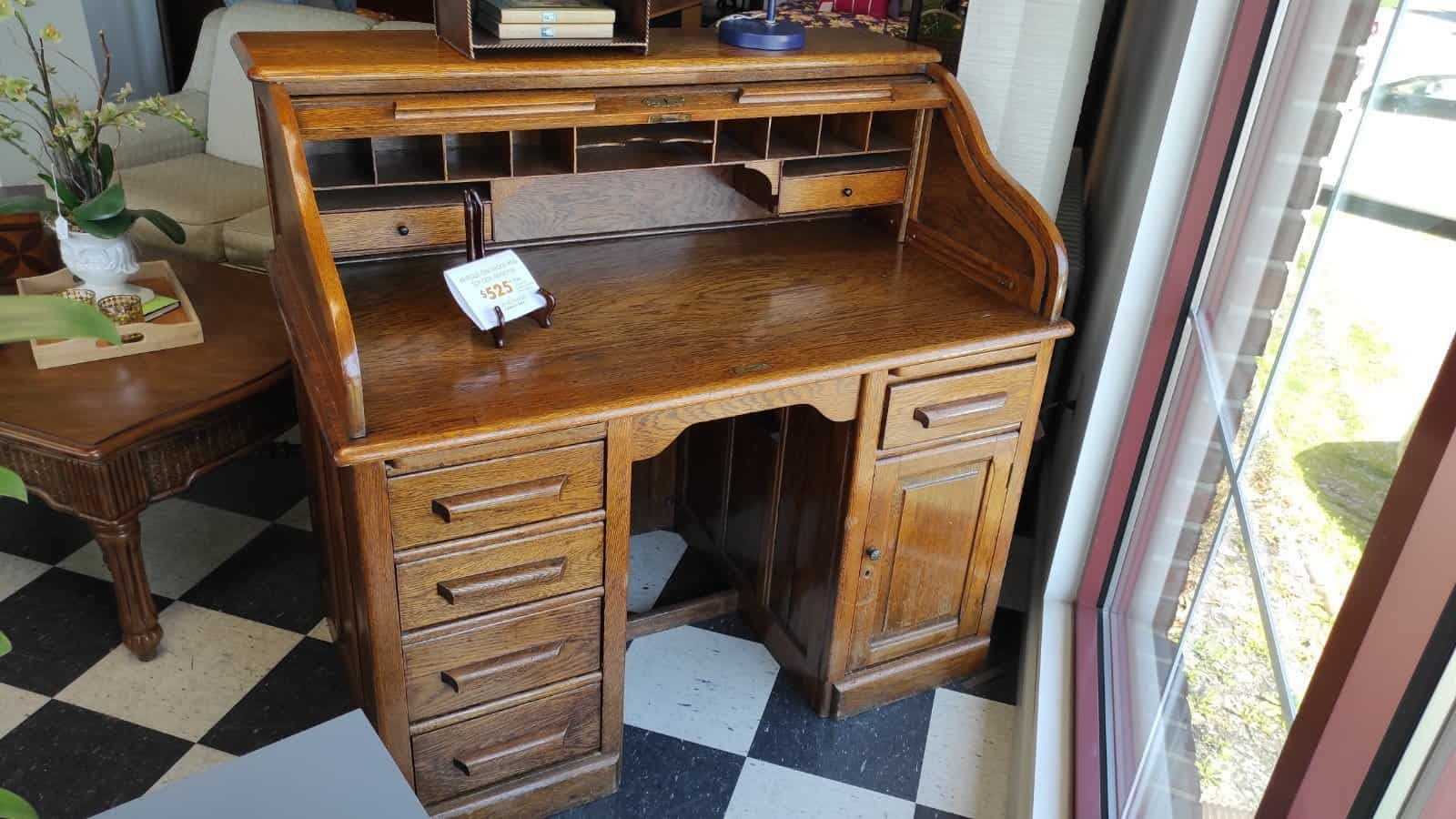Since the arrival of the Industrial Era, the furniture industry has grown exponentially with the use of steam machines. The reduction of manufacturing costs and specialized labor allowed the enjoyment of high-quality desks for homes and more luxurious offices.
Among these beauties stands out the creation of more specialized and complex models, like the Roll Top Desk. A Desktop that in its beginnings was born as a variant of the classic Cylinder desk, but today, it is one of the best models of Antique desks. Interested? Keep reading.
Table of Contents
What is a Roll Top Desk?
The Antique roll-top desk is a desk that combines the pedestal desk model with the cylindrical model created in France during the decade 1760. This one featured a curved door that could be pulled out, thus concealing the desk.
This feature is preserved in the design of the roll-top desk but implements a flexible wooden slatted shutter that is retractible vertically in the upper section of the desk. When sliding the roll-top opening, you could appreciate an elegant wooden desk with built-in lockers and shelves.
Unlike its predecessor, the roll-top desks were much bigger, where the writing surface and cabinets were enlarged, and the carved legs were replaced with more expansive and spacious side drawers.
Furthermore, in some cases, small storage drawers were inserted in the back of the desk, like the Carlton House model, for example.
The Beginning of the Roll Top Desk
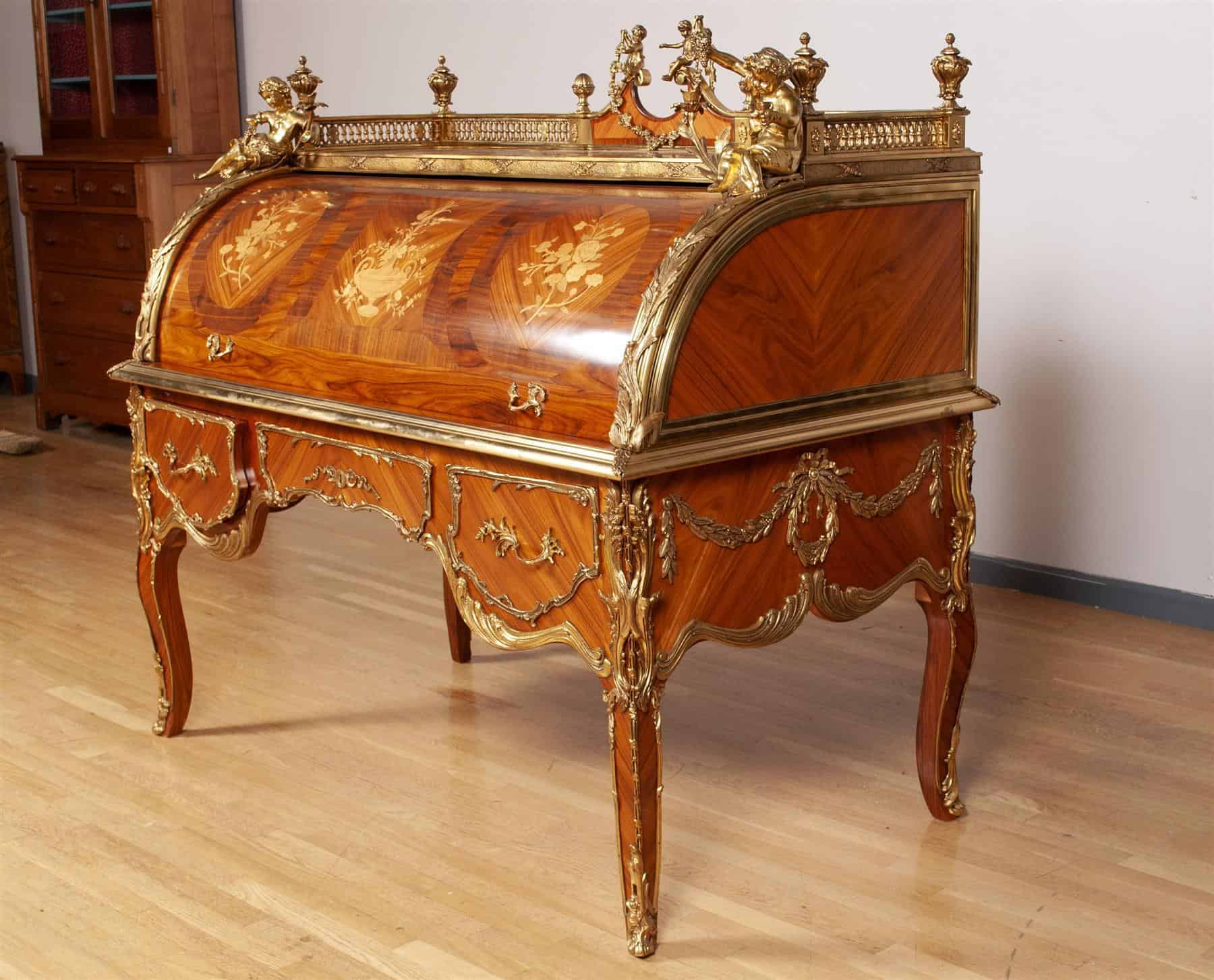
The roll-top desk is one of the most popular items among antique collectors. This elegant and sophisticated desk came to light thanks to a king’s petition. Yeah, everything was due to the wishes of King Luis XV of France.
Luis XV or more known as Luis the Beloved, was especially interested in a writing station, capable of being sophisticated and elegant, but at the same time, closing and locking up. That is why he sent for his skilled cabinetmaker, Jean Francois Oeben, and requested him to create a desk for him.
However, Jean Francois Oeben could not live long enough to complete and witness his work, but he dedicated the last three years of his life. Upon his death, his successor, Jean Henri Reisner, committed six years more in order to finally polish and ended the famous desk of King Luis XV (1760-1769).
From France to the World
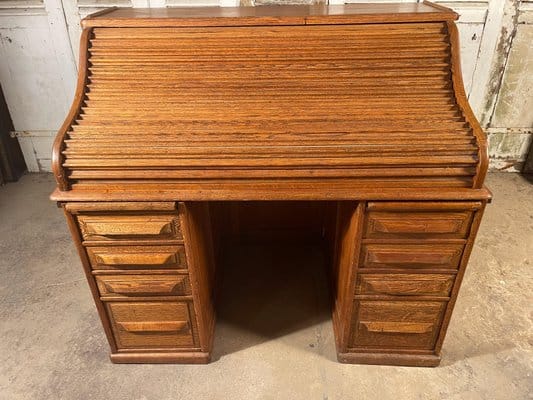
This exciting and sophisticated roll-top desk design had to wait at least a century to make an impact in the furniture industry. Then, at the end of the 18th century, the model established by Luis XV passed from France to England.
During that time, they enjoyed great popularity and were produced with good English oak. Some pioneer companies in the desk elaboration of this kind were the Aring Company, Gillows, Lebus, Inglesants, and the Angus company from London. At the end of the 19th century, it was a must-have item in the offices.
It is worth mentioning that the roll-top desk benefited from the fact that the primary form of communication at that time was letters. So its original and sophisticated design was right on the money for the people at that time.
At that time, when the roll-top desk went from England to the United States. Its arrival in America triggered the mass production of large amounts, under the catchphrase “each thing in its place and a place for each thing.”
These models presented a rolling door that could slide up and down, allowing you to conceal or reveal, among other things, lockers, shelves, secret drawers, and a flat surface to write on; many expensive models came with a leather writing surface.
On the other hand, one of the first patents of the roll-top desk in America was granted to Abner Cutler in 1881. Abner was the owner of A. Cutler & Son, located in Buffalo, New York. Its roll-top desk design differed from previous models due to its flexible tambour door.
This tambour could cover the whole desk and papers when they were not in use, and after Cutler’s success, most roll-top desks were created following his design. If you own or are thinking of acquiring one of the most antique Cutler’s roll-top desks, you will have to pay a good amount of money because they are one of the rarest and most valuable models.
The Decline of the Roll-Top Desks
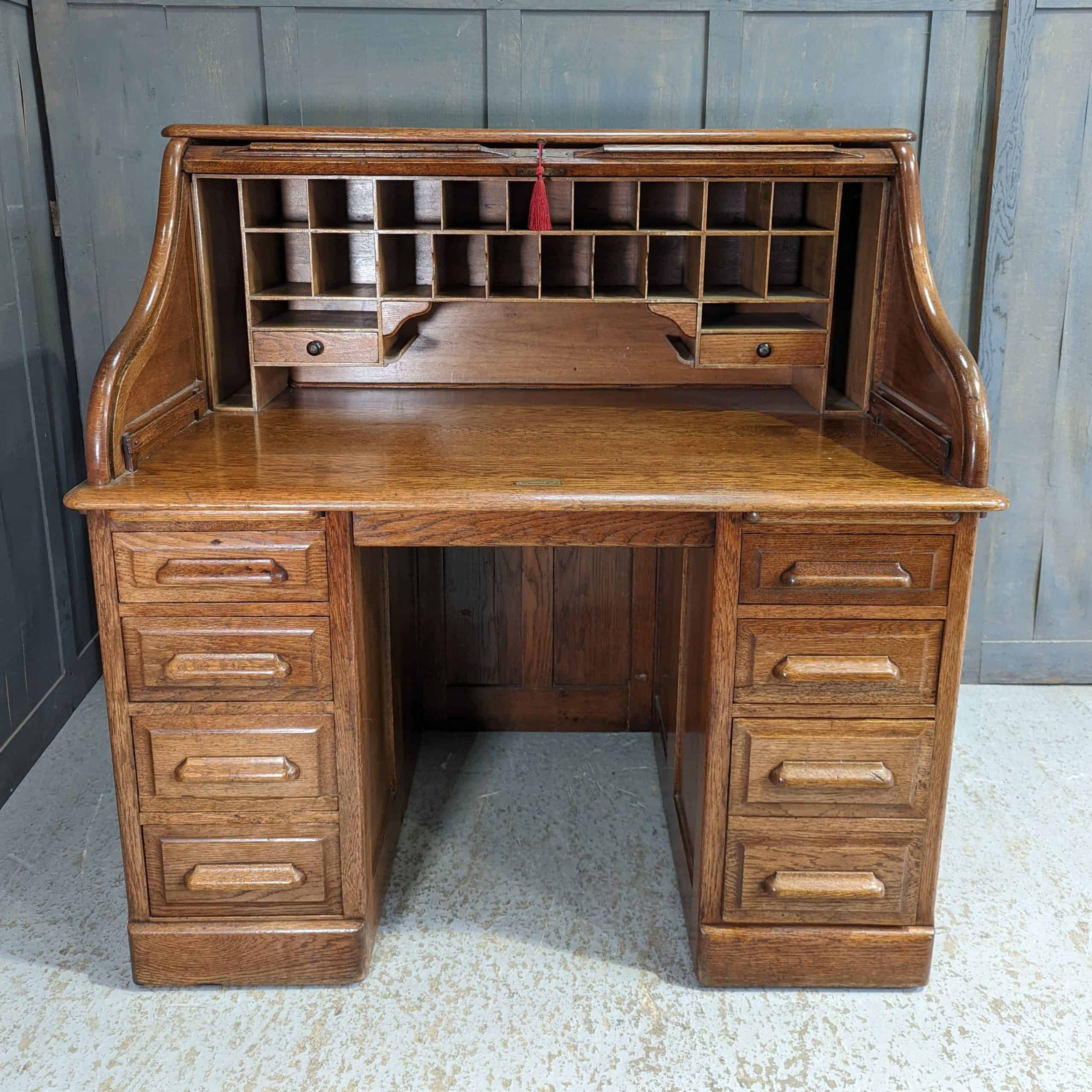
With the arrival of the 20th century and the arrival of elegant glass and steel desks, people’s preferences changed, and the roll-top desks, like other wooden models, clearly declined in popularity.
To this, we have to add up a more significant space demand to store large quantities of documents for big and mid-sized companies, which is why the roll-top drawers turned inadequate, giving way to the creation of another essential piece of furniture like is the case of the file cabinet.
Popular Manufacturers of Roll Top Desks
Finding a valuable roll-top desk in good condition can be a little bit tricky because these will not always have the trademark of the companies that manufacture them. However, some companies have made themselves known for their own design when it comes to roll-top desks. Some of these are:
- Agus of London: As mentioned before, this English manufacturer was one of the highest standards of the roll-top desk. From the end of 1800 until 1900, it has stood out for its high-quality desks.
- Waring & Gillow: It has been dedicated to furniture fabrication since 1731, with Robert Gillow’s lead in elaborating furniture pieces, Until 1903, when the company was absorbed and became known as Waring & Gillow.
- The Cutler Desk Company: It grew from a small cabinet-making store to one of the most relevant manufacturers of roll-top desks, with large-scale production.
- The Globe Company: The company was founded in 1882 and dedicated to making office equipment from the late 19th century to the early 20th century, taking its designs to parts of England under the label of Globe-Wernicke Cold Co Ltd.
How to Determine if Your Roll Top Desk is Antique?
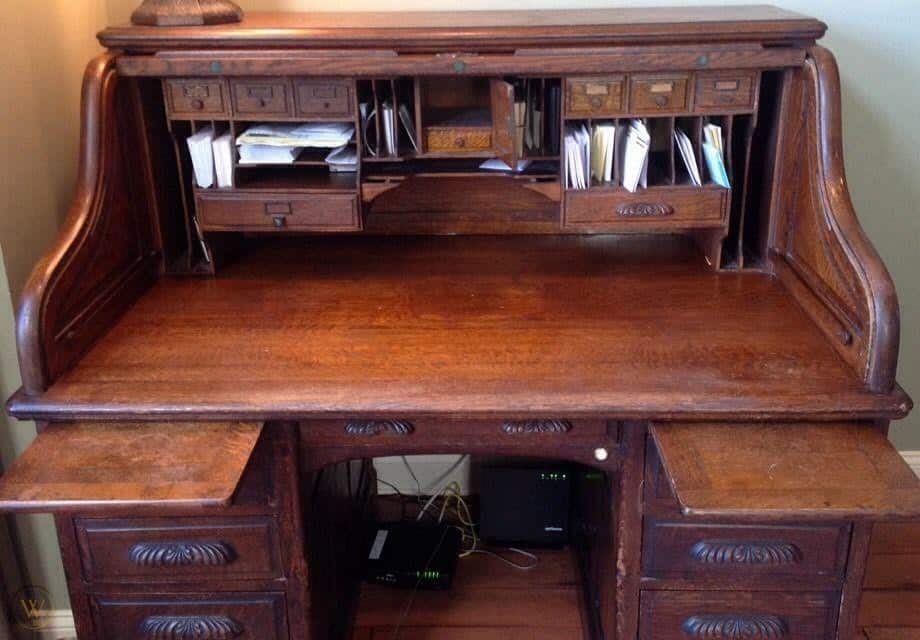
In order to know the age or antiquity of your roll-top desk, you must be aware of the visible clues its aspect reveals. Taking this into consideration, take the following steps:
- Start by inspecting the wood: Knowing what kind of wood your desk is made of is one of the first visible clues that will help you to determine the age of your roll-top desk. The most ancient desks of this kind were fabricated with cherry wood, mahogany, or black walnut wood, unlike those manufactured from 1900 onwards, when it became common to use oak wood.
- Take measurements of your desk: The complete set of dimensions of your desk will reveal whether these were machine-made or handmade. Whatever the height, the depth, the width of the tambour, etc., everything must be taken into consideration. It should be noted that the asymmetrical measurements reveal a process made by a machine, so it probably means that it was manufactured between 1880 and the end of 1920.
- Examine the dovetail joints: The most ancient desks possess irregular dovetail joints due to being hand-cut, while those made with machines have a more refined and clean appearance. For this reason, pull out one of the desk drawers and verify if the dovetail joints have a triangular form like a bird’s tail and keep the boards together perfectly; if this is the case, then it was surely fabricated at the end of the 19th century or in following years.
- Manufacturer’s trademarks: Some manufacturers would put logos or hidden marks that can help you date the creation of your desk. But, you have to be careful if a label not that old is found, because this could mean that it was added in modern times, so it would not be of much use to corroborate its antiquity.
- Check how the tambour was made: Some roll-top desks possess a tambour that is connected through slats, while others are attached to a canvas or linen backing. Furthermore, tambours of the 18th century presented a C-curve slat design, and the ones of the 19th and 20th centuries an S-curve.
- Look for more clues among the clues: The age of a roll-top desk can be visible if you notice any old locking mechanism implemented in it, stamps with names like Derby Desk Company and Shannon File Company, which were the first manufacturers. In addition to this, the roll-top desks that have been in use for over a century have evident signs of this, like bumps, scratches discoloration of the patina, among others (heads up! Beware of repetitive or intentional wear and tear, these are signs that the desk is not antiquity).
- Go to the library: It may be that if you look in the library for catalogs, books, and old office equipment magazines, you can maybe find a picture and a detailed description of your roll-top desk, giving you the date of fabrication of it.
- Go to the professionals: If the doctors know about medicine, the certified appraisers and antiquity merchants know how to establish and validate the age of an ancient ítem; that is why you should take your time in going to this kind of professionals that are an excellent and precise resource for verifying the age of your article.
Factors That Can Influence the Value of Your Roll-Top Desk
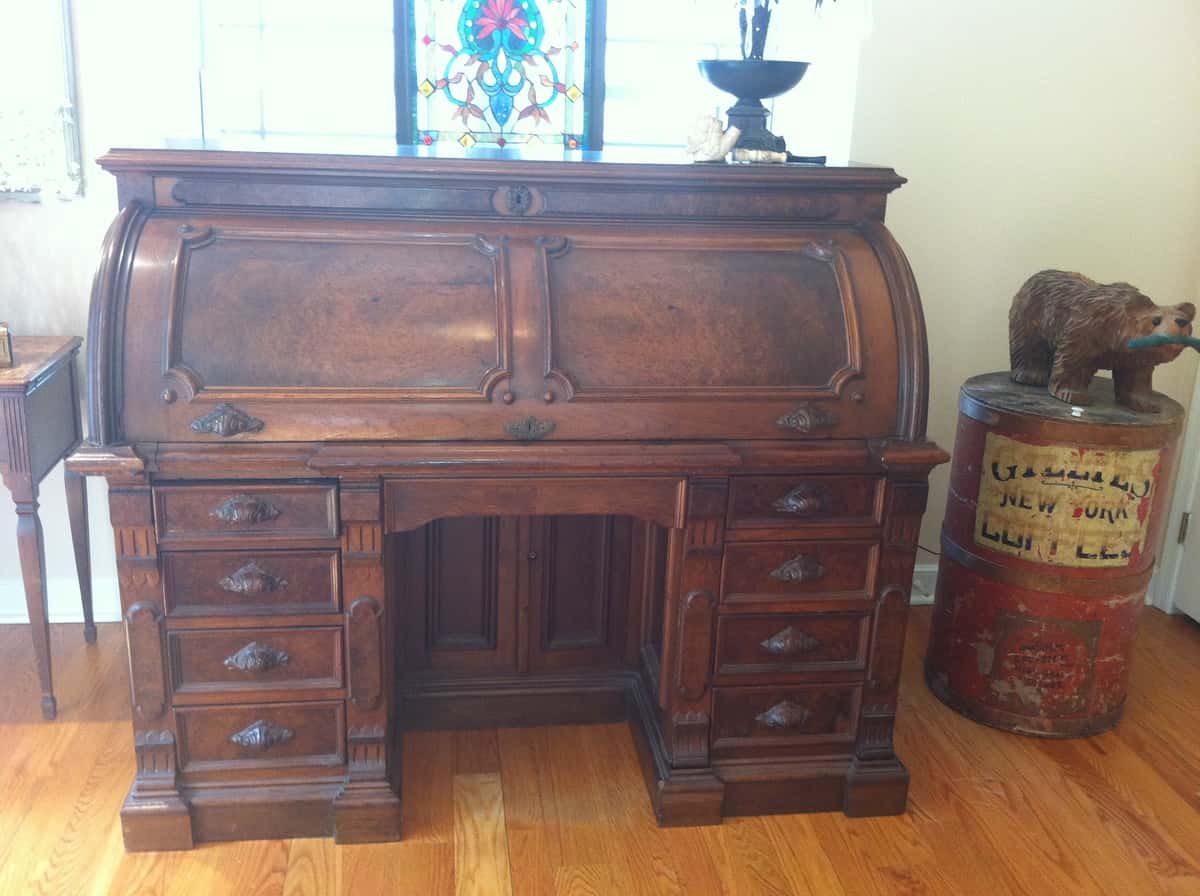
- Age: In general terms, age or antiquity is the most crucial factor in pricing the value. The older the desk, the higher value it may have if it is in good condition; this is why particular emphasis should be placed on verifying the age of your roll-top desk or the one you are about to buy.
- Status of the desk: No matter how old the desk may be, for the desk to be in excellent condition is essential. Furthermore, modifications and repairs that may have been carried out on them are also a factor. For example, has it been painted or refurbished? If that is the case, the value of the furniture goes down; this can also happen if it possesses cracks, missing slats in the tambour, significant scratches, and other imperfections that affect the item’s condition.
- Craftsmanship: Desks with a lot of handwork like cravings and moldings that have been elaborated with high-quality increase the value of the desk.
- Materials used: The most ancient desks were made of cedar, oak, and other quality woods mentioned before. However, by the beginning of the 20h century, plywood began to be used in parts like the drawers since it was less expensive, and although the oldest desks have in these parts cheaper woods like pine, the plywood reduces its value.
- Provenance: If the desk you own or want to buy belonged or was used by someone important or famous, it will increase the furniture’s value, but only if it can be proved that it was owned by someone influent.
- Rareness: The roll-top desks have pretty unique models because of their rarity, like the case of the Cutler Roll top, which tend to be rarer than others.
Steps to Restore an Antique Desk
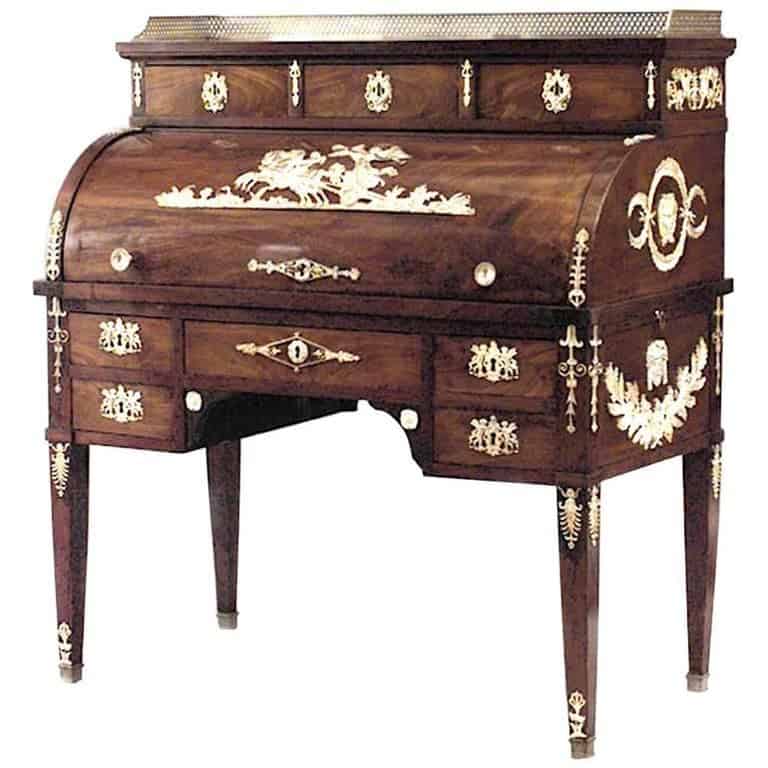
Restoring antique furniture is a creative and rewarding DIY project that anyone can do. What are these steps? Continue reading below:
Step 1 Clean the Desk
An essential step for any furniture restoration Project is thoroughly cleaning the furniture piece; This is especially important if the article has been stored or put outdoors for an extended time.
For this, it is especially simple and useful to clean the furniture piece with dish soap and warm water. Use a sponge and clean the piece with soft movements. In case the desk has some milling traces or carvings a brush is the best choice for deep cleaning.
After that, all left is rinse with water and a wrung-out sponge until the soap has dried, and finish by wiping with a towel.
Step 2 Check the Condition of Your Desk
This is also an essential step since it will help you evaluate the restoration scale that your desk needs. Observe what repair procedures are required, if it has drink rings, Paint stains, or any of the kind; also, find out what items you will need to carry out the restoration.
Likewise, keep in mind that depending on the analysis of the state of your desktop, you will have to:
- Refurbish: If your desk keeps the existing carving, the only thing you need to do is to wax and clean the surface of the piece. In these cases, the wood of the furniture tends to be in good condition.
- Repair: In these cases, repairing dents and cracks from worn-out areas might be necessary. The piece’s finish can be maintained, but special products should be implemented to fix your desk.
- Refinish: If you notice that your desk needs a refinish, use a product to eliminate the original finish or use an electric sander machine. After that, do the necessary repairs and reapply new finishing touches to your desk.
Step 3 Remove the Old Finish
You can do this step in two ways:
- Sanding: In this scenario, you can use coarse sandpaper or an electric sander. No matter what you choose, you must sand until the surface is smooth and the finish is not so noticeable, and then move on to using medium-grade sandpaper; this should remove the gloss altogether.
- Chemical stripper: This type of product is designed to remove the piece’s finish effortlessly. Choose a liquid product or semi-paste and extend it above the wood surface with a bristle brush. Make sure to do it uniformly. After that, let the chemical stripper rest according to instructions, and when you see that the Surface material has wrinkled, proceed to remove it with a scraper. You can use a lacquer thinner to remove any residue left from the chemical stripper.
Step 4 Apply a Coat of Sealant
After removing the finish from your furniture, you must coat it. First, you must ensure no residue is left on your desk. Then you must proceed to seal the wood to prepare it for staining. If you do so, the sealant product will protect the wood of your furniture and will serve as a base for the wood to be painted uniformly.
Remember to be generous with the sealant coat; make it thick and let it penetrate the wood. Once this process is completed, remove the excess with a clean cloth, and when the sealant is completely dry, sand the desk Surface with a fine-grit sandpaper.
Step 5 Paint the Wood
This is a personal decision, not an essential step; it will all depend on your criteria and what you expect from the furniture restoration. But remember:
- If the piece is quite archaic, it is possible that you do not want to Paint it to not rest monetary value or keep its authenticity.
- If the color or grain of the wood displeases you, maybe the best thing to do is to Paint your furniture in a color that suits your taste.
- If the desk is in a transited area, the painting will protect the furniture.
- If the piece contains stains you could not remove, consider painting it so you can cover them.
Step 6 Apply a Coat of Finish
After the previous steps, the last thing to do is apply a top coat. You can choose between different kinds of coating with a brush or cloth (oil finish, cleaning varnish, polyurethane varnish, among others); make sure you are adequately informed about how to use each one of them and that they are suitable for your desk.
How Much Does a Roll-Top Desk Cost?
The price of ancient roll-top desks may vary depending on the abovementioned factors. But, some examples of sales of such items have left digits of purchase of just over $3000 for a desk of the 1860 decade, auctioned online.
Sales have also been made from $4500 to $6000 or $7000. The first number was because of an American roll-top desk of the 1920 decade, and the ones after that were the value of an Edwardian roll-top desk.
Where to Buy a Roll-Top Desk?
If you are interested in not spending much money and just buying a good article for vintage decoration, many have had a better experience at secondhand stores. You can find some treasures and even roll-top desks in good condition for less than $100. On the other hand, you can find crown jewels at antiquities auctions; other sellers can have them for even more than $10000.
Conclusion
Each antique has its own history and charm, and so does the Roll Top Desk. If you also own one, welcome to value it according to the above ways. Besides, we also teach you how to restore it with professional guidance.
